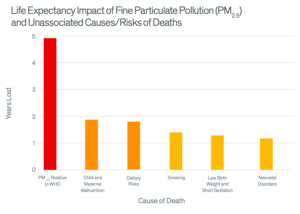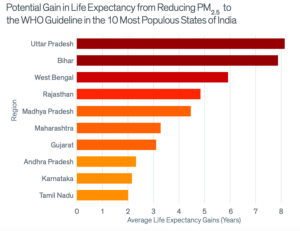ForumIAS announcing GS Foundation Program for UPSC CSE 2025-26 from 19 April. Click Here for more information.
Contents
- 1 Introduction
- 2 What is Particulate Matter?
- 3 What is the Air Quality Life Index (AQLI)?
- 4 What are the key findings of Air Quality Life Index?
- 5 How dangerous is Particulate Matter?
- 6 What is the significance of the Air Quality Life Index?
- 7 What are the reasons behind deteriorating air quality in India?
- 8 What steps have been taken towards reduction of air pollution?
- 9 What steps can be taken going ahead?
- 10 Conclusion
| For 7PM Editorial Archives click HERE → |
Introduction
The recently released Air Quality Life Index (AQLI) shows a dismal picture of India with respect to the degree of air pollution. It has ranked India as the world’s second most polluted country. The AQLI Analysis noted that the air pollution shortens average life expectancy in India by 5 years (relative to what it would be if the World Health Organization (WHO) standards on fine particulate pollution (PM2.5) were met). Some areas of India fare much worse than average, with air pollution shortening lives by almost 10 years in the National Capital Territory of Delhi, the most polluted city in the world. The report is a reminder for the Governments to take proactive measures for giving the masses a cleaner air to breathe.
What is Particulate Matter?
Particulate matter, or PM, is the term for particles found in the air, including dust, dirt, soot, smoke, and liquid droplets. They remain suspended in the air for long periods of time. Some particles are large or dark enough to be seen as soot or smoke. Others are so small that individually they can only be detected with an electron microscope.
Many manmade and natural sources emit PM directly or emit other pollutants that react in the atmosphere to form PM.
These solid and liquid particles come in a wide range of sizes. Particles less than 10 micrometers in diameter (PM10) pose a health concern because they can be inhaled into and accumulate in the respiratory system.
Particles with diameters between 2.5 and 10 micrometers are referred to as ‘coarse’. Particles less than 2.5 micrometers in diameter (PM2.5) are referred to as ‘fine’ particles and are believed to pose the greatest health risks. Due to their small size (approximately 1/30th the average width of a human hair), fine particles can lodge deeply into the lungs.
Exposure to fine particles can cause short-term health effects such as eye, nose, throat and lung irritation, coughing, sneezing, runny nose and shortness of breath. Exposure to fine particles can also affect lung function and worsen medical conditions such as asthma and heart disease. Long term exposure to fine particulate matter may be associated with increased rates of chronic bronchitis, reduced lung function and increased mortality from lung cancer and heart disease.
What is the Air Quality Life Index (AQLI)?
The AQLI is released by the Energy Policy Institute at the University of Chicago (EPIC) every year.
It is a pollution index that translates particulate air pollution into one of the most important metric: its impact on life expectancy. The AQLI is rooted in recent research that quantifies the causal relationship between long-term human exposure to air pollution and life expectancy.
The Index then combines this research with hyper-localized, global particulate measurements.
The recently released report has considered 2020 as the base year and included the revised guidelines of WHO. Last year, WHO had revised its guidelines and reduced the safe limit for PM 2. 5 from 10 micrograms per cubic metre to 5 micrograms per cubic metre.
What are the key findings of Air Quality Life Index?
India is the second most polluted country in the world after Bangladesh. Nepal, Pakistan and Democratic Republic of Congo were placed at third, fourth and fifth position.
All of India’s 1.3 billion people live in areas where the annual average particulate pollution level exceeds the WHO guideline of 5 µg/m3. Further, more than 63% of the population live in areas that exceed the country’s own national air quality standard of 40 µg/m3.
Particulate pollution is the greatest threat to human health in India, reducing life expectancy by 5 years. In contrast, child and maternal malnutrition reduces average life expectancy by about 1.8 years, while smoking reduces the average life expectancy by 1.5 years.
Source: EPIC
Temporal: Particulate pollution has increased over time. Since 1998, average annual particulate pollution has increased by 61.4%, leading to a further reduction in average life expectancy of 2.1 years. Since 2013, about 44% of the world’s increase in pollution has come from India.
Source: EPIC
Region Specific Findings: In the Indo-Gangetic plains of Northern India, 510 million residents are on track to lose 7.6 years of life expectancy on average, if current pollution levels persist. Similarly, residents of Lucknow stand to lose 9.5 years of life expectancy if pollution levels persist.
Source: EPIC
How dangerous is Particulate Matter?
In 2019, over 7 million deaths annually were linked to exposure of various pollutants in the world with analysts claiming that around 80% of deaths attributed to PM2.5 exposure.
Among all classes of air pollutants, inhalable PM2.5 is considered the most hazardous as it gets deposited in lungs through breathing and causes serious respiratory problems.
AQLI noted that the impact of air pollution on life expectancy is comparable to that of smoking, more than three times that of alcohol use and unsafe water, six times that of HIV/AIDS, and 89 times that of conflict and terrorism.
What is the significance of the Air Quality Life Index?
First, it presents unprecedented insight into the true cost of particulate pollution in communities around the world.
Second, the Index also illustrates how air pollution policies can increase life expectancy when they meet the WHO’s guidelines for what is considered a safe level of exposure.
Third, the information presented by AQLI can help to inform local communities and policymakers about the importance of air pollution policies in concrete terms. Thereby inducing them to formulate robust policies.
What are the reasons behind deteriorating air quality in India?
First, vehicular pollution mainly due to trucks, tempos and other diesel-run vehicles. These vehicles negate the impact of cleaner fuel and emission technology.
Second, combustion in power plants and industries using dirty fuels, like pet coke, Fuel Oil and its variants, coal and biomass release hazardous air pollutants.
Third, garbage burning, both in landfills and other places where there is no collection, processing or disposal.
Fourth, road dust; dust due to construction sites etc. also adds to the particulate pollution.
Fifth, use of insecticides, pesticides and fertilizers in agricultural activities release ammonia which is a major air pollutant.
Further, large-scale burning of crop residues in the States of Punjab, Haryana and western Uttar Pradesh contributes significantly to the air pollution in the Delhi NCR Region every year. The climatic conditions during winter aggravate the condition.
What steps have been taken towards reduction of air pollution?
National Clean Air Programme (NCAP): It aims to reduce particulate pollution by 20 to 30% by 2024, relative to 2017 levels. The NCAP targets are non-binding.
| Read More: National Clean Air Programme (NCAP) |
National Air Quality index (AQI): The AQI classifies air quality of a day considering criteria pollutants through colour codes and air quality descriptor. Further, it also links air quality with likely human health impacts. The index measures eight major pollutants, namely, particulate matter (PM10 and PM2.5), nitrogen dioxide, sulphur dioxide, ozone, carbon monoxide, ammonia and lead.
The Air (Prevention and Control of Pollution) Act, 1981: It provides for the prevention, control and abatement of air pollution. It calls for the establishment of Boards at the Central and State levels with a view to carrying out the aforesaid purposes.
What steps can be taken going ahead?
First, the Government should provide all forms of support (money, staff and infrastructure) for timely achievement of NCAP targets. According to AQLI, a permanent, nationwide reduction of 25% would increase India’s average national life expectancy by 1.4 years.
Second, emphasis should be laid on reducing emissions from thermal power plants and industry by instituting strong emissions standards. There should be a strong monitoring and enforcement system that ensures limits are met and excess emissions lead to punishments.
Third, the Government should incentivise the use of machines like happy seeders to curb pollution from stubble burning. Further innovative methods should be adopted to reduce the magnitude of crop residue along with creation of a market for the use and management of stubble outside of the field (ex-situ management).
Conclusion
There is mounting evidence about the effects of air pollution on health. The important message from new studies and analysis is that is air pollution related deaths and illness are preventable. Reducing pollution and meeting clean air targets can save lives. Given its widespread impact, combating air pollution should be one of the top agenda for the Union and State Governments
Source: The Times of India, The Times of India, Down to Earth, EPIC








